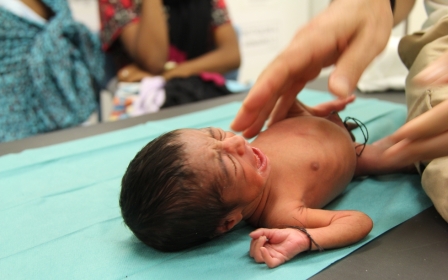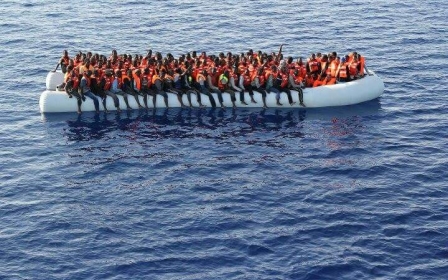There can be no end to the tragedy in the Med while Libya is in chaos

In the last four days of August, the Italian coastguard coordinated the rescue of over 13,000 Middle Eastern and North African migrants who were attempting to cross to Italy in rubber boats and wooden vessels, a headlines-grabbing event that many media outlets have failed to contextualise.
First, this sudden spike in the number of migrants from the Middle East and North Africa region attempting to reach Europe via illegal channels does not translate into an increase in the average number of migrants doing so. Actually, the number has decreased.
According to the latest data released by the United Nations (UN), since the European Union (EU) outsourced the management of the so-called migration crisis to Turkey, the number of refugees from Syria and Iraq using illegal channels to arrive from Turkey to Greece through the Aegean Sea has decreased.
The number of people trying to reach Europe from Libya and Egypt has also decreased. According to the latest report of the International Organisation for Migration (IOM), so far this year 278,327 people have arrived to Italy, Greece, Cyprus and Spain from Libya and Egypt, that is 76,291 less people than last year during the same period of time.
The number of fatalities on the Mediterranean Sea, however, has increased: fatalities in 2016 so far stand at 3,171 - 515 more fatalities than IOM reported through the first eight months of 2015.
Second, the late August 2016 surge in the number of Middle Eastern and North African migrants attempting to reach Europe via the central Mediterranean Sea route is not only due to recent favourable sea and weather conditions.
There is a more complex explanation: The domestic situation in Libya determines the number of departures from the country – as much as sea and weather conditions do.
Libya as the new trafficking hub
Following the fall of the regime led by Muammar Gaddafi in 2011, human-trafficking networks capitalised on the power and security vacuum that ensued, and established an industry that provided desperate Middle Eastern and North Africans – both asylum seekers and economic migrants – with passage from North Africa to Europe.
In little time, Libya became a transition country for thousands of these people.
Today, the country is still immersed in a conflict, and, as in every conflict, there are periods of time that are tense, and other periods that are less tense. If the situation on the ground is tense, migrants entering Libya from the east, the south, and the west are forced to stay in safe areas until they can reach their departure points on the Libyan coastline, which is located in the north of the country.
On the other hand, if the domestic situation is less tense, these migrants can move within the lawless country and reach their departure points where they embark en masse for Europe.
Therefore, the factors that determine the number of migrants attempting to reach European soil are both favourable sea and weather conditions, and the level of tensions in Libya.
Until there is a stable government in Libya, and a unified army with the capacity to control Libya’s borders and waters, there will be more spikes in the number of people risking their lives in the Mediterranean Sea – even if the overall numbers doing so decreases gradually.
Libya’s political transition
After the overthrow of Gaddafi in 2011, the country gradually descended into violence and chaos. Since the official end of the NATO intervention in support of the anti-Gaddafi forces in October 2011, no post-intervention plan for the stabilisation of Libya was implemented – a major failure of the international community.
There were national elections in July 2012 and further legislative elections during 2014, but the emergence of powerful armed militias in a country awash with weapons led to a complicated power struggle between different political forces and armed groups.
Amid the chaos, human-trafficking networks established an illegal industry in the country. In little time, the industry thrived.
First, there was a market opportunity. The number of Middle Eastern and North African migrants fleeing war and poverty in their respective countries of origin was constantly increasing, and so was the demand for illegal passage to Europe.
Second, there was impunity. Libyan criminal judicial system was not functioning, and thus, the members of human-trafficking networks could easily establish their businesses and operate without constraint.
Finally, the situation on the ground rapidly worsened, guaranteeing a lawless future, and therefore, the continuity of the business.
By autumn 2015 there were six major warring sides in Libya: the House of Representatives (HoR), the General National Congress / Libya Dawn, the Islamist Shura Council of Benghazi, al-Qaeda forces, the self-proclaimed Islamic State (IS), and ethnic and tribal forces.
The situation improved in late 2015. After 14 months of negotiations, a Government of National Accord (GNA) was formed under the terms of the United Nations-brokered Libyan Political Agreement. As the GNA gained executive power and its affiliated forces took control of the country, IS started to loose territory in the north.
In May 2016, a coalition of armed groups affiliated with the GNA launched a military campaign to liberate the coastal city of Sirte from IS control. In recent weeks, these armed groups have seized strategic sites on the city’s outskirts, and announced that the final phase of the campaign against the terrorist group is pretty imminent.
As a consequence, the number of migrants attempting to cross the Mediterranean Sea decreased in 2016. Tensions in the country, particularly in the north, have impeded many migrants from reaching their departure points in the Libyan coastline.
What to expect next
Under the terms of the Libyan political agreement, the HoR is the legitimate legislative authority, and enjoys the right to approve the members of the GNA.
But the legitimacy of the GNA is threatened by continuing political rivalries with the HoR. On 22 August, the HoR passed a vote of no confidence against the GNA led by Prime Minister Fayez al-Sarraj.
The next few weeks could determine whether Libya will maintain a semblance of political unity or descend into chaos once again, leaving open the possibility of an IS resurgence.
In regard to the so-called migration crisis, the European Union (EU) has taken measures to continue reducing the number of migrants attempting to reach Europe via Libya.
On 23 August, the EU Naval Force Mediterranean, also known as Operation Sophia, signed a memorandum of understanding with the Libyan coastguard that aims at improving the latter’s ability to secure its territorial waters, and stopping the flow of migrants from Libya to Italy.
These efforts will only be effective if the political transition in Libya is successful.
Still, there will be more spikes in the flow of migrants and refugees risking their lives in the Mediterranean Sea – even if the numbers gradually decrease – until the causes forcing these people to flee their countries of origin are addressed.
- Tania Ildefonso Ocampos is a Spanish political analyst who specialises in EU strategy in the Middle East. She is a former Schuman trainee (Euro-Med and Middle East Unit of the European Parliament's Directorate-General for External Policies), and holds an MA in Middle Eastern History from Tel Aviv University, Israel.
The views expressed in this article belong to the author and do not necessarily reflect the editorial policy of Middle East Eye.
Photo: Men from Bangladesh rest in a room at the Interior Ministry's al-Nasr housing centre for illegal immigrants on 31 August 2016 in the port city of Zawiyah, located some 45 kilometres west of the Libyan capital Tripoli. (AFP)
Middle East Eye propose une couverture et une analyse indépendantes et incomparables du Moyen-Orient, de l’Afrique du Nord et d’autres régions du monde. Pour en savoir plus sur la reprise de ce contenu et les frais qui s’appliquent, veuillez remplir ce formulaire [en anglais]. Pour en savoir plus sur MEE, cliquez ici [en anglais].





